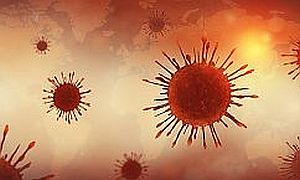A US study has found "unambiguous" evidence of live COVID-19 virus in aerosols, contracting the World Health Organisation's position statements transmission, writes MedicalBrief.
Sceptics of the notion that the coronavirus spreads through the air – including many expert advisers to the World Health Organisation – have held out for one missing piece of evidence: proof that floating respiratory droplets called aerosols contain live virus, and not just fragments of genetic material. Now, reports The New York Times, a team of virologists and aerosol scientists has produced exactly that: confirmation of infectious virus in the air.
“This is what people have been clamouring for,” said Linsey Marr, an expert in airborne spread of viruses who was not involved in the work. “It’s unambiguous evidence that there is infectious virus in aerosols.”
The New York Times reports that a research team at the University of Florida succeeded in isolating live virus from aerosols collected at a distance of seven to 16 feet from patients hospitalised with COVID-19 – farther than the six feet recommended in social distancing guidelines. The report says the findings have not yet been vetted by peer review, but have already caused something of a stir among scientists. “If this isn’t a smoking gun, then I don’t know what is,” Marr tweeted.
But some experts said it still was not clear that the amount of virus recovered was sufficient to cause infection.
The report says the research was exacting. Aerosols are minute by definition, measuring only up to five micrometres across; evaporation can make them even smaller. Attempts to capture these delicate droplets usually damage the virus they contain.
“It’s very hard to sample biological material from the air and have it be viable,” said Shelly Miller, an environmental engineer at the University of Colorado Boulder who studies air quality and airborne diseases. “We have to be clever about sampling biological material so that it is more similar to how you might inhale it.”
The NYT says in the study, researchers devised a sampler that uses pure water vapour to enlarge the aerosols enough that they can be collected easily from the air. Rather than leave these aerosols sitting, the equipment immediately transfers them into a liquid-rich with salts, sugar and protein, which preserves the pathogen.
“I’m impressed,” said Robyn Schofield, an atmospheric chemist at Melbourne University in Australia, who measures aerosols over the ocean. “It’s a very clever measurement technique.”
The report says the researchers had previously used this method to sample air from hospital rooms. But in those attempts, other floating respiratory viruses grew faster, making it difficult to isolate the coronavirus.
This time, the team collected air samples from a room in a ward dedicated to COVID-19 patients at the University of Florida Health Shands Hospital. Neither patient in the room was subject to medical procedures known to generate aerosols, which the World Health Organisation (WHO) and others have contended are the primary source of airborne virus in a hospital setting.
The genome sequence of the isolated virus was identical to that from a swab of a newly admitted symptomatic patient in the room.
The room had six air changes per hour and was fitted with efficient filters, ultraviolet irradiation and other safety measures to inactivate the virus before the air was reintroduced into the room.
That may explain why the researchers found only 74 virus particles per litre of air, said John Lednicky, the team’s lead virologist at the University of Florida. Indoor spaces without good ventilation – such as schools – might accumulate much more airborne virus, he said.
But other experts said it was difficult to extrapolate from the findings to estimate an individual’s infection risk.
Abstract (not peer reviewed)
Background – There currently is substantial controversy about the role played by SARS-CoV-2 in aerosols in disease transmission, due in part to detections of viral RNA but failures to isolate viable virus from clinically generated aerosols.
Methods – Air samples were collected in the room of two COVID-19 patients, one of whom had an active respiratory infection with a nasopharyngeal (NP) swab positive for SARS-CoV-2 by RT-qPCR. By using VIVAS air samplers that operate on a gentle water-vapor condensation principle, material was collected from room air and subjected to RT-qPCR and virus culture. The genomes of the SARS-CoV-2 collected from the air and of virus isolated in cell culture from air sampling and from a NP swab from a newly admitted patient in the room were sequenced.
Findings – Viable virus was isolated from air samples collected 2 to 4.8m away from the patients. The genome sequence of the SARS-CoV-2 strain isolated from the material collected by the air samplers was identical to that isolated from the NP swab from the patient with an active infection. Estimates of viable viral concentrations ranged from 6 to 74 TCID50 units/L of air.
Interpretation – Patients with respiratory manifestations of COVID-19 produce aerosols in the absence of aerosol-generating procedures that contain viable SARS-CoV-2, and these aerosols may serve as a source of transmission of the virus.
Authors
John A Lednicky, Michael Lauzardo, Z. Hugh Fan, Antarpreet S Jutla, Trevor B Tilly, Mayank Gangwar, Moiz Usmani, Sripriya, N Shankar, Karim Mohamed, Arantza Eiguren-Fernandez, Caroline J Stephenson Mahbubul Alam, Maha A Elbadry, Julia C Loeb, Kuttichantran Subramaniam, Thomas B Waltzek, Kartikeya Cherabuddi, John Glenn Morris Jr, Chang-Yu Wu
[link url="https://www.nytimes.com/2020/08/11/health/coronavirus-aerosols-indoors.html"]Full report in The New York Times[/link]
[link url="https://www.medrxiv.org/content/10.1101/2020.08.03.20167395v1"]medRxiv abstract (not peer reviewed)[/link]
See also
[link url="https://www.medicalbrief.co.za/archives/covid-19-transmission-the-global-misuse-of-data/"]COVID-19 transmission – The global misuse of data[/link]
[link url="https://www.medicalbrief.co.za/archives/covid-19-transmission-an-absence-of-data/"]COVID-19 transmission — An absence of data[/link]
[link url="https://www.medicalbrief.co.za/archives/covid-focus-must-stress-prevention-and-good-early-treatment/"]COVID focus must stress prevention and good, early treatment[/link]

